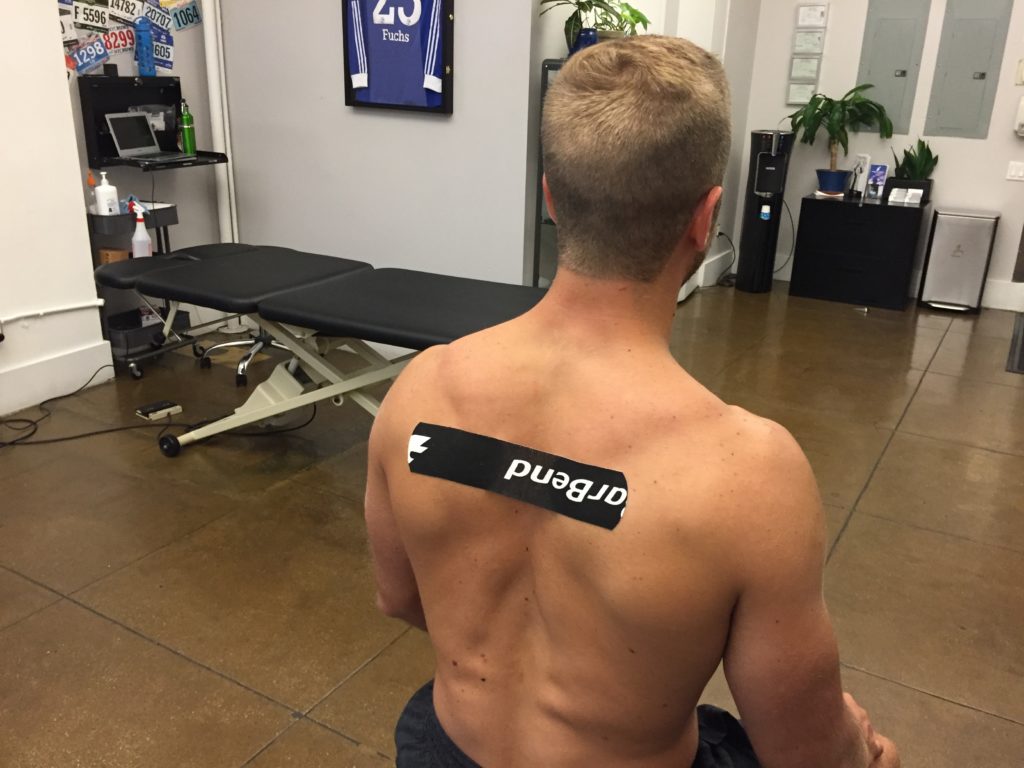Strength athletes generally understand that kinesiology tape serves its main purpose in the gym and for recovery, but where else can kinesiology tape help? What about at the office and throughout your day? In comes taping for posture. As we spend more time at computers, driving, and looking at our phone, we continue to slouch and acquire kyphotic-esque posture (rounding of the upper back).
These postures can impact our health negatively in multiple ways, and this includes performance in the gym. To learn a simple one-step method to assist our posture, we reached out to Joe Gambino, PT, DPT, and CSCS at Perfect Stride Physical Therapy, New York City. Check out the easy posture taping method in the video and text description below.
Note: All motions shown are for informational purposes only. The information in this article and video is not meant to prevent or cure any disease or injury. It’s always a good idea to consult with a medical professional or trainer before attempting any new training methodology. If you experience any sharp pain while exercising, discontinue movements immediately.
How Can Tape Support Posture?
One of tape’s main roles is to send proprioceptive feedback to the brain. Basically, when we apply a light touch or tension with tape on the skin, then our brain picks up on signals to produce a desired effect. In this case, it’s to signal the brain to move away from slouching postures. Below are a few areas of the back the tape will be touching.
- Rhomboids
- Trapezius
- Teres Minor/Major
As we slouch more, these muscles can becomes overly stretched and weak. In return, we begin to move and feel increasingly more comfortable in a less than optimal posture, aka slouched posture. This taping method will pull on these muscles as we slouch, so our brain is signaled to sit up right and retract the shoulder blades back.
1. One-Step Posture Strip
This taping method will require the assistance from a friend, and will be difficult to apply alone.
To begin, the athlete will need to either sit or stand with a tall correct posture. The shoulder blades should be slightly retracted, the head should be neutral, and the torso should remain tall/long.
Next, measure a piece of tape that spans from shoulder blade to shoulder blade, and round the edges. Tear the tape in the middle to create a band-aid effect and place the center adhesive between the shoulder blades. Create a 20-50% stretch on each side of the tape, and thoroughly rub the tape in.

Tips for Posture Taping with Kinesiology Tape
- Create Tension: A lighter 20-50% tension will work best with this taping method. If the tape is too tight, then it may lose it effectiveness at a faster rate.
- Proprioception: As an athlete begins to slouch, the tape will create a sense of tension, or pull on the shoulder blades, and subconsciously cue the athlete to sit up tall with correct posture.
- Hair and Taking It Off: If you’re excessively hairy in a specific area, then you’ll pull off little pieces at a time, and use your hand to gently repeatedly chop the tape off (in a karate chopping motion). You can also pinch the skin to release some of the tapes tension, while taking it off in a partitioned manner.
- Cut the Edges: The final tip was the cut the edges of the tape, so it’s rounded. This will prevent the corners from getting caught on edges of clothes and shoes.
Final Word
Slouching and poor posture can impact gym performance and quality of daily life. This simple taping method can be beneficial for anyone in need of a simple subconscious to to keep the shoulder blades retracted, and maintain an upright tall posture.